Hidden away just east of the Mount Hope Cemetery on the University of Illinois campus is a non-descript brick building with a non-descript sign that reads “Meat Science Laboratory.” For those in the know, that sign causes uncontrollable salivation and Technicolor flashbacks of juicy roasts, glorious barbecues, and heavenly smoked sausages. Like Pavlov’s dogs, we’ve been trained to queue up every Tuesday, Thursday, and Friday because inside that building is the “Meat Sales Room” — hands-down the best butcher shop in Champaign-Urbana. Best of all, it’s still a best-kept secret and somehow that makes everything you buy there just taste better.
If you park outside and watch, you’ll see a steady stream of people coming out with precious bundles of white butcher-paper-wrapped packages and a knowing smile on their faces. That smile seems to betray the fact that they just know dinner tonight is going to be damn good.
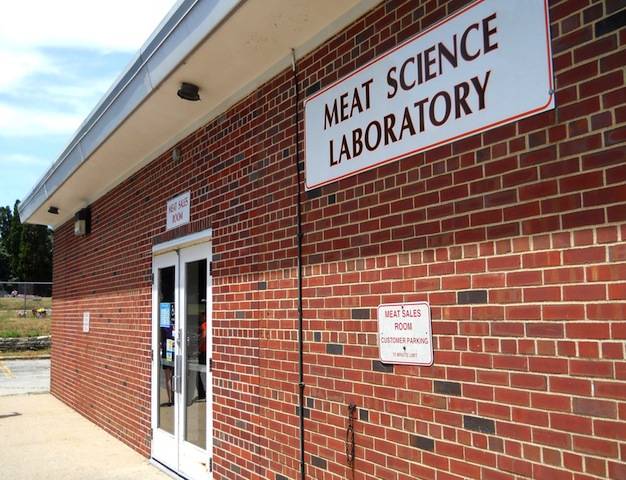
Once you enter the building, you’ll see barren floors, bare walls, some old-fashioned signage, and virtually no decoration of any kind. Is this a laboratory or a store? Are there mad scientists in there experimenting on animals or what? Well, don’t fret, just behind the crowd of people queued up by the counter are two meat display cases containing the freshest locally sourced meats available. On a typical day, you might find pork roasts, rib-eye steaks, lamb chops, fresh bratwurst, filet mignon, flank steak, spare ribs, and much, much more. On some days, they’ll have fresh chickens. On other days, they have specialty cuts like heart, liver, and kidneys. I’ve even seen pork hocks and beef tongue.
Turn around and you’ll see two more refrigerated cases filled with sausages, bacon, jerky, and eggs. You’ll have to ask, but in the frozen coolers behind the counters are frozen chickens, hamburger patties, and other bulk goodies. That leg of lamb? Bought here in the Meat Sales Room. The best bratwurst I’ve ever tasted? Only available here. The best chicken I’ve had in ages? Chuck’s smoked chicken, which he only makes once in a blue moon.
Chuck who? Meet Chuck Stites, the “Meat Mail” guy. Meat Mail is the email list that Chuck manages and sends out at least once a week. If you’re on his list, you get a personal message from Chuck telling you what’s available, what’s fresh and what’s on sale at the Meat Sales Room. Those that pick up the phone immediately and call in their order always get the goods. Those who wait and meander in later that day might be out of luck as the good stuff moves fast.
Those of us on Chuck’s Meat Mail list always look forward to getting our weekly updates. Sure, we find out what’s new and good, but we also find out what Chuck had for dinner last night. Sometimes we get insights on what goes on behind the scenes at the Meat Sales Room. Sometimes we get poetry. Sometimes we get a novel (well, at least the title of a novel, like “It Was the Best of Times, It Was the Wurst of Times”). After a few years, I feel like I kinda know this guy and I like him. Yet, I’ve never met him. So I did something about it. I called him up and asked for an interview.
Smile Politely: So how did “Meat Mail” get started?
Chuck Stites: We used to send out price sheets through Campus Mail and U.S. Mail. There were a few people that were on our mailing list, but most of the flyers went out as bulk mail on campus. At some point as more and more people got communicating with email, I stopped sending out the paper flyers and started sending out sales information by e-mail. I really don’t know when “Meat Mail” officially began. I suppose that there may be a file or folder hidden away on my computer someplace that would be the first Meat Mail. I do know that Meat Mail was birthed by my desire to build a relationship with my Meat Sales Room customers. I believe that the best thing a business can do to be successful is to build relationship of trust with their customers.
SP: You have a lot of fans out there who really enjoy reading “Meat Mail,” yet most people don’t even know your name. What makes you want to put so much energy into these emails?
CS: People will take their business to places they have a relationship with. You’ve heard people talk about going to the local butcher shop, bakery, market, etc. with mom or grandma. She knew the owners and they would always tell her what’s good or fresh today. Over time, you build a trusting relationship with that place of business. I see Meat Mail as a modern version of that.
SP: But Meat Mail is not just about marketing and what’s on sale today.
CS: That’s right. I use Meat Mail to educate and amuse. For example, I might tell my Meat Mail customers that we got in 36 pigs in today. I’ll tell them that we slaughtered the pigs so that they know that it’s fresh and they’ll also know where their dinner came from—that it’s not a just a piece of meat in the case, that this was an animal that was raised for food. Even though not everybody wants to think about it, meat does come from animals. That is why we have animal agriculture. Evidently not all meat eaters are aware of that. There are people out there that say things like “instead of killing animals, why don’t you just go to the grocery store instead.” They just don’t make that connection.
SP: Everything you say makes sense; a marketing professor will probably say the same thing.
CS: In Animal Sciences, our focus is research, teaching and extension. The Meat Sales Room is not really part of that mission statement. Our operation is necessary though because doing the teaching and research generates meat products. Marketing the product is something that needs to be done and how we go about doing that is kinda up to me.
SP: You put a lot of your personality into Meat Mail. I think readers find them authentic. Something in your soul must make you want to do that.
CS: Before you get to know me personally, you would think that I don’t have much of a sense of humor and that I’m always very business-like and straightforward. Some people think that I look mad all the time, but that’s just the way I look. What you see is what you get. I am genuine. I don’t put on any airs otherwise. But once people get to know me they realize that I have a sense of humor. I’m pretty quick with wit, puns, or even coming up with different words to a song. Meat Mail is an outlet. My mind is always going, thinking about one thing or another.
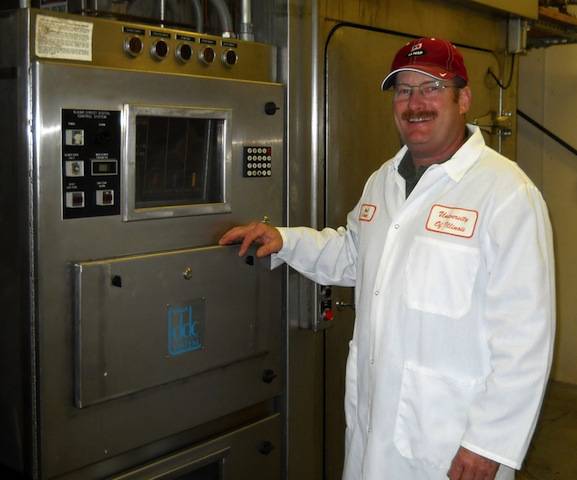
SP: Do you do any other writing other than Meat Mail?
CS: No I don’t write anything else. But as an undergrad I took a creative writing class in college. Even in high school, I did some creative writing, like poetry. I have the ability; I just don’t take the time.
SP: How long has the Meat Sales Room been around?
CS: The best records show that the Meat Sales program has been around for 60 years. We used to be in Davenport Hall up on the Quad, where all the meat processing took place. That was when the slaughter facilities were in the Stock Pavilion on Pennsylvania Avenue. In the beginning, most meat sales were either fresh retail or wholesale. Some of the wholesale products may have been sold to campus Dining Services since they had a meat department back then, or sold to local meat processors.
SP: When did you move to the building you’re currently in?
CS: 1981 this facility—which used to be the large animal veterinary clinic—was renovated. This brought the slaughtering and processing of meat under one roof. The folks who designed the facilities did not want to deal with any fresh meat sales. They envisioned wrapping everything and putting it in the freezer because they didn’t want to deal with the short shelf-life of these perishable products.
SP: And today, you have the best butcher shop in town.
CS: I think that is a subjective statement. There are other places in town that provide different services than we do, such as a vast deli department or take-out meals. If those are services that you desire, then we would fall short. However, I believe that we are the only place in town that cuts whole beef, pork, and lamb carcasses. We have the flexibility to cut items to unique specifications if some of our customers demand that service. We try to ensure that the meats that we offer to our customers are of high quality and value, that they will be proud to serve their family and friends.
SP: How many regular customers do you have today?
CS: I could look at the journal tape on the cash register and tell you how many transactions occur per week, but as far as putting a number on “regular customers,” I am not really sure. I see some customers regularly once or twice a week. Others may come in periodically, or only at holidays. At this time there are around 2500 people that subscribe to Meat Mail. Of course not all of them come in each week. In fact I know that some of the subscribers are not our customers, they may live out of state or out of the country. They just like getting Meat Mail.
SP: How did you grow to where you are today?
CS: There have been a lot of things that have kind of fell into place in the past few years. People’s desire to purchase locally was one of them. Some people place a high value on knowing where their food comes from. Five years ago or so, the News-Gazette came in and did an article about us. It was about a full page and a half. The title was something like “The secret is out.” I would have to say that article was kind of a launching point for us.
SP: Have you always wanted to run a meat processing plant?
CS: No. I grew up in a farming community. I came to the University of Illinois to go to college. Once here I was offered the opportunity to take the job I have now and go to graduate school. That was about 30 years ago. I took that offer and have been here ever since. About 20 years ago, my family and I started a business at our home that does deer processing for hunters. Hunters bring their deer to us and we cut them up and make sausages, etc.
SP: So it’s a family business?
CS: It’s something I started. My wife and four kids are all involved in it. We’ve got some awfully cute pictures of the kids helping cleanup or wrap when they were little. The business is called River Bend Wild Game & Sausage Company.
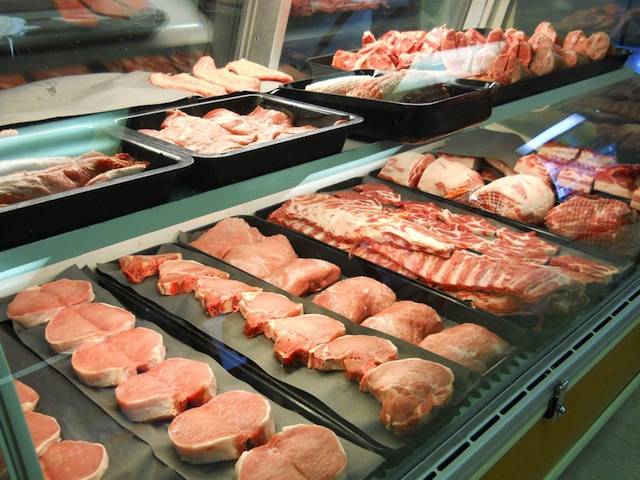 SP: How did you learn to do all this?
SP: How did you learn to do all this?
CS: As I was growing up, hunting and fishing were a big part of my life. We hunted rabbits, squirrels, deer, etc. I started my “butchering experience” by cleaning fish. In 1972 when deer season opened up in Coles County where I was from, my grandpa decided he wanted to cut up a deer. He did it on the kitchen table and made a mess. That’s when he decided to get things set up down in the basement to do things properly. He put in a walk-in cooler, got a cutting table, a meat grinder, meat saw, etc. Once he got the equipment, we started doing our own hog and cattle butchering in addition to the deer that were harvested. This was a family activity, so even as a kid I helped. Growing up I had exposure those experiences.
SP: What about sausage making? Isn’t that sort of an art?
CS: As far as sausage making goes, the skills I have today I picked up working here. When I was as senior here at the U of I, I started working in this building as an undergrad. During my senior year I had a lot time to work, so I got a lot of practice cutting and making sausages.
SP: Yeah, your sausages taste pretty damn good. Especially the bratwurst.
CS: Some of the recipes that we use are the same ones that we had when I started here. Back then, we really only made smoked sausage, summer sausage, and bratwurst.
SP: Where did that bratwurst recipe come from?
CS: I don’t know exactly where the fresh bratwurst recipe came from. The story goes, that somebody came to school here a long time ago whose family was in the meat business and this was a recipe that his grandfather used. I don’t know if that’s true or if it is just an urban legend.
SP: What about all the other sausages?
CS: The other recipes that we use for the sausages that we make are either ones that I found elsewhere and used verbatim or that I adapted from other recipes to get a flavor that I liked. I’ve got one sausage recipe that a gentleman gave me—it’s a really good andouille sausage recipe that he supposedly got from a gentleman in Louisiana. When I decided to make beef jerky, I accumulated over 30 recipes and made all of them one day. After trying all of them, we decided to use an adaptation of a recipe that my grandma used at home, but made it a little spicier.
SP: I’m a big fan of your bratwurst. What’s the secret ingredient?
CS: I’m not gonna say.
SP: So it’s a secret recipe.
CS: Yep. There are hundreds if not thousands of recipes for bratwurst. If you go to Wisconsin any sausage up there can be called a “brat.” They make cranberry brats, pistachio brats—I’ve had brats from big national companies that don’t quite taste right to me just because I am used to the flavor of ours. There’s one name brand that uses sage in their bratwurst. I think of sage as being in a breakfast sausage. I just don’t associate it with a bratwurst taste.
SP: I like the small-town neighborhood feel of the Meat Sales Room, everything from the butcher paper wrapping and the signs. But what goes on behind the scenes?
CS: Meat Science is part of the Department of Animal Sciences which is part of the College of ACES (College of Ag before the name change). There are a variety of disciplines within animal sciences—from genetics, nutrition, physiology and animal husbandry. We focus on poultry, sheep, pigs, and beef in our program. All disciplines are involved in the production of meat. For instance, when we raise pigs we need to know genetics so we get the right characteristics of the pig. We need to know what to feed the pig so nutritional sciences will come up with the right diet to maximize growth. Housing is important so that the animals can grow with access to feed and water, whether inside or out at a stocking rate that is best for raising animals. If all of the other divisions of Animal Science have done their job, we should end up with high quality, nutritious meat products. Meat science is involved in the conversion of muscle to meat.
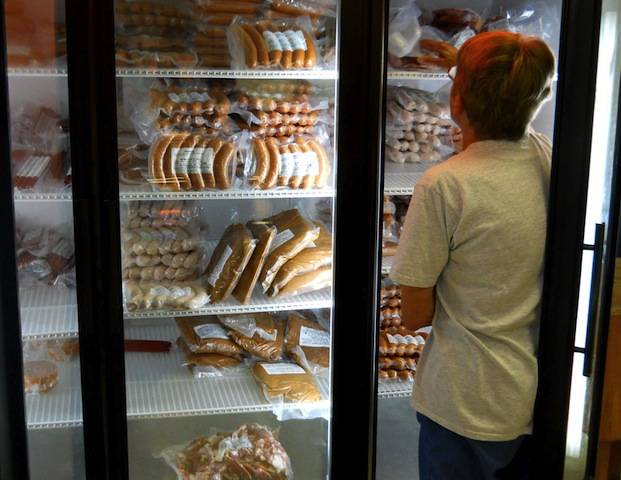
SP: So you’re in charge of this entire building?
CS: I am in charge of the first floor. The second floor contains offices for faculty and students in addition to their laboratories. The first floor is a federally inspected meat processing plant. Any place that is selling meat that has a label on it has to be inspected and that’s done by government employees. Their job is to make sure the food is safe from any communicable disease, and is safe for human consumption. In any place that slaughters livestock, you will have inspectors who go down the line to make sure the animal is alive healthy and being handled humanely. They will be there on the kill floor, in the slaughter area making sure that the animals are being stunned humanely and proper sanitary procedure are being carried out. They look at the carcass to make sure it is fit for human consumption. They also make sure that our processing rooms and equipment are sanitary and that food is produced safely (for the consumer).
SP: So the animals are slaughtered in the next room and then the meat is brought up to the sales room. Wouldn’t that make you the freshest butcher in town?
CS: I imagine that is probably true. By products (liver, hearts, kidneys, tongues, etc.) are offered for sale the same day that the animals are slaughtered. Pork may be offered for sale a day or two after it is slaughtered. Beef is generally aged for at least a week or two before it is offered for sale. Aging is done to improve flavor and tenderness. Pork can benefit from aging somewhat, but it really makes a difference for beef.
SP: What kind of research do you do here?
CS: We do a variety of things. If a research project is being done in order to measure yield of saleable meat from an animal, we may do cutting tests. Cutting tests involve cutting carcasses consistently and taking lots and lots of weights. Other projects may involve meat quality with traits of importance being color, juiciness and tenderness. Differences in tenderness can be done mechanically and by eating. There is a mechanical measurement of tenderness which involves taking a steak for example, and cooking it to a certain degree of doneness — most of the time that would be medium rare. A sample of that steak would be placed into a mechanical device is that would measure how much force it takes to cut through that portion of steak. It’s a mechanical measurement of tenderness that correlates to your eating pleasure.
SP: Are there studies done for flavor?
CS: We also have what we called taste panels where we do sensory evaluations. During taste panels, six panelists eat a uniform sized portion of meat. They would then note their perception of juiciness, tenderness, and flavors.
SP: Sort of works like wine tastings?
CS: I suppose that it is similar, however, the panelists are not allowed to speak to each other or see each other during the evaluations, lest they would influence each other’s observations. There are trained panels, experienced panels and consumer panels. The people that we use here would be pretty much the experienced panels. Most of the time our panelists are faculty, staff or grad students that work in our building.
SP: I understand you have a smoke house.
CS: Yes we do. Back in the pioneer days, smokehouses would have been wood buildings located on most farms in which the farmer/butcher would hang their meats in. They lit a fire off to the side and allowed the smoke to come in contact with the meat. They put a real heavy smoke on it and they used it as a preservative more than anything. Today we have a piece of equipment that is more like a big oven where you can regulate the heat and humidity. You can also regulate the amount of smoke you put on the product.
SP: Well, the stuff that comes out of your smoker tastes damn good.
CS: The smoke we put on the product comes from the burning of hickory sawdust on an electrically heated plate whose temperature is adjusted to the right temperature to create smoke without a flame. Of course nowadays we don’t use smoke so much as a preservative so much but as a flavoring or coloring to make products taste and look more appealing.
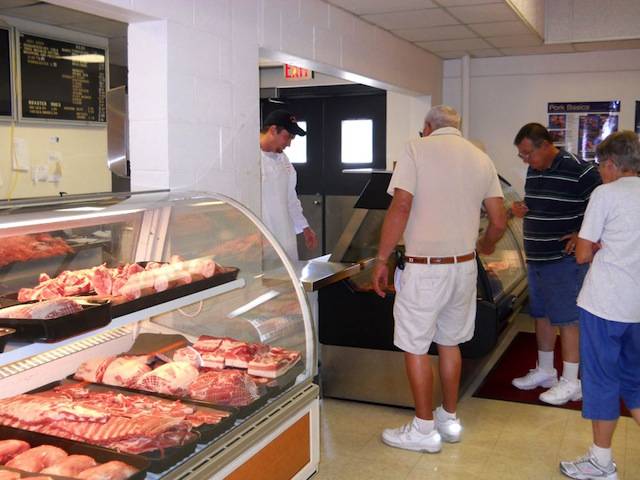
SP: How do you make the smoked chicken taste so good?
CS: We cure the smoked chicken the same way we do bacon or ham. We have a piece of equipment we use that is called an injector. We mix up our ingredients—salt and other ingredients in water—then we pump it into the meat with needles to disperse it like a “Cajun” injector that you can buy in a store.
SP: Is it the smoke itself is that’s cooking the chicken?
CS: The smoker is heated with electric heating elements just like your oven at home. The temperatures we use are lower than you would use in your oven and the time is generally longer. For example, with cured and smoked ham the cooking cycle is 10 hours and the temperature would range between about 100 to 180 degrees for different stages of the cooking cycle. There are fans that move air and a steam that is provided to control the humidity. You can cook things pretty quickly even though it’s at a lower temperature.
SP: Are the animals you use locally sourced?
U of I’s livestock farms are on the south end of campus. We have two swine farms on South First Street and one on South Race Street. The beef farm is on South Race just down the road from the poultry farm. The dairy farm is located on South Lincoln. You may also see cows on pasture if you drive around south campus. We also have a farm in southern Illinois at Dixon Springs and one in western Illinois called the Orr Center.
SP: Are the animals on the U of I farms raised in factory farms?
CS: Factory farming means different things to different people. With modern agriculture, they use those technologies that they use for good reason. With things like housing and nutrients for example, it’s not something someone does without a great deal of thought. Agriculture is a way of life, as well as a business. As with any business farmers have adapted their farming practices to take advantage of new technologies for labor savings, increase production and out of a desire to be more efficient—reducing cost, reducing time to market, while still keeping quality high. If a farmer houses his animals in climate controlled buildings with proper ventilation and space for each animal, makes sure that they have plenty of feed containing the proper amounts of energy and nutrients, makes sure they have free access to water, has proper waste disposal, and makes sure that his animals have proper veterinary care does that make his farm a factory farm?
SP: Does the U of I do any research for organic or alternative farming?
CS: Not really. Our farms are going to use normal agricultural practices that any other farmer in the USA would use. At this time, we don’t have any range feeding or organic type of program. You might think that organic farming is a simpler thing to do, but it’s actually more complicated. You need more land, you need more time for the animals to reach market. Therefore, the cost to produce animals in this way is generally higher, so the cost of the animal products (meat) is generally going to be higher. The great thing about our country is that we are affluent enough that if a consumer wants a certain thing, that choice is probably available somewhere for a price. If they want organically raised free range chickens or this specific breed of cattle they can find it. Some farmers have decided that they want to exploit this niche market. You will see their offerings in some stores, farm stands, or farmer’s markets.
SP: Well, I certainly enjoy shopping here. I think of you as my local neighborhood butcher shop.
CS: Thank you. If anyone would like to receive Meat Mail, they can Google “University of Illinois Meat Salesroom.” The link will take you to a website from which you can subscribe to Meat Mail. We are open Tuesday and Thursday afternoons 1-5:30 and Friday morning 8-1.








